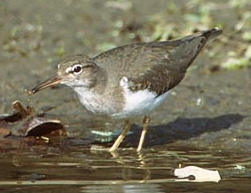Spotted Sandpiper
|
|
| Spotted Sandpiper | ||||||||||||||
|---|---|---|---|---|---|---|---|---|---|---|---|---|---|---|
| Missing image Actitis-macularia-005.jpg Spotted Sandpiper | ||||||||||||||
| Scientific classification | ||||||||||||||
| ||||||||||||||
| Binomial name | ||||||||||||||
| Actitis macularia (Linnaeus, 1766) |
The Spotted Sandpiper, Actitis macularia is a small shorebird.
Adults have short yellowish legs and an orange bill with a dark tip. The body is brown on top and white underneath with black spots. Non-breeding birds, depicted below, do not have the spotted underparts, and are very similar to the closely related Common Sandpiper, A. hypoleucos. Like that species, they have a distinctive stiff-winged flight low over the water.
Their breeding habitat is near fresh water across most of Canada and the United States. They nest on the ground. Females may mate with more than one male, leaving the males to incubate the eggs.
They migrate to the southern United States and South America. It is a very rare vagrant to western Europe. These are not gregarious birds and are seldom seen in flocks.
These birds forage on ground or water, picking up food by sight. They may also catch insects in flight. They eat insects, crustaceans and other invertebrates.
Actitis-macularia-004.jpg

